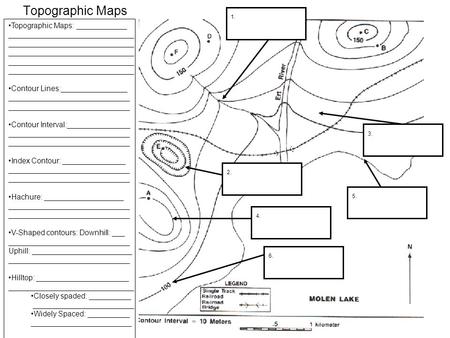

The handout entitled Relief and Contour Lines shows some of these patterns. Relief means the height and shape of the land. The height is marked alongside.Īs we have seen by looking at contour lines we will be able to visualise what a hill or a valley will actually look like.Īs we have seen in the video the pattern made by contours tells us a lot about the relief of the land. The height is marked on the map by a blue triangle with a dot in the middle.

Triangulation pillars: are often found on hill tops.

Layer Shading: maps are sometimes shaded to show the height of land. Spot Heights: a spot height shows exact heights by a black dot with a number next to it.

There are other ways how height can be shown on maps besides the use of contours. You can also use contour lines to determine the direction the river is flowing as water always flows downhill. The bottom of the V points in the upstream direction. Contours that form a V can tell you which direction water will flow. Valleys and stream flow: Contour lines on the map also show how water will travel across the land. For example:Ī rounded hill: may be showed as closed concentric contours.Ī Cliff: if you see two or more contour lines converge until they appear as a single line, this represents a cliff. Where contours are further apart elevation is changing slowly, indicating a gentler slope and when far apart they indicate flat terrain.Ĭontour lines give us a lot of information and show us the shape of the terrain. Where contour lines are close together, elevation is changing rapidly in a short distance and the terrain is steep. To determine elevations, pay attention to the amount of space in between lines. To avoid the map being cluttered with numbers only index contours are labelled with height values. To make topographical maps easier to read, every fifth contour line is darker and wider in colour. However contour lines are usually drawn at 10 metre intervals on a 1:50,000 scale map and at 5 metre interval on a 1:25,000 scale map. Different maps use different intervals depending on the topography. For example, if your map uses a 10 metre contour interval, you will see contour lines for every 10 metres of elevation – lines at 0, 10, 20, 30, 40 and so on. We call the spacing between contour lines the contour interval. The change in elevation from one contour line to the next is always the same within the same map. Such maps with contour lines on them are called topographical maps. In fact these lines are very useful because they illustrate the shape of the land surface or its topography on the map. These videos will help us understand what contour lines represent and how useful they are to interpret relief of the land.īesides height above sea level contours also show the shape of the terrain. Topographical maps and contour lines can present a major challenge to understand. Image 1 shows how cartographers (map makers) managed to devise an ingenious way to show three-dimensional topography on a two dimensional flat surface with the use of contour lines. If on the other hand the numbers associated with the contour lines are decreasing, there is a decrease in elevation. If the numbers associated with specific contour lines are increasing, the elevation of the terrain is also increasing. Thus a contour line with a 60 metres marking indicates that any place along that contour line is 60 metres above sea level. If you were to walk the path of a contour line in real life, you would remain at the same elevation the whole time, never travelling up and down. Contour lines show height of the ground above mean sea level (MSL) in metres. Contour lines are imaginary lines drawn on Ordnance Survey maps connecting points of equal elevation and are used to illustrate relief on a map.


 0 kommentar(er)
0 kommentar(er)
